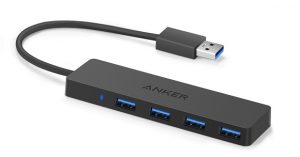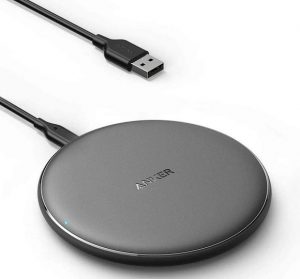Anker weighs in on a chain of hubs, USB on the high Cs
Picture the scenario, you’re wandering the halls of the average technology trade show and you casually pick up a small four-port USB-C data hub and sling it into your bag without thinking too much.
It’s probably branded with the name of the ‘gold sponsor’ for the show i.e. the one that couldn’t afford the platinum sponsorships package that comes with keynote logo flash and the branded lunch napkins.
Over time, you suddenly realise how useful that little thing is and it comes with you on every trip you make, enabling you to whack two USB ‘sticks’ (aka thumb drives), one smartphone cable charger and one additional travel keyboard into its connectors.
Most standard PCs these days are built with two (maximum three) USB ports and you can quickly use those up with your Bluetooth mouse connector, a tablet power cable and smartwatch. This means that extending outwards from one of those slots so that one-becomes-four is actually pretty crucial.
But (remember we’re telling a story here) once you lose that hub connector (it was only a show freebie after all) you suddenly realise how much you needed it. Mine is somewhere on the floor of Aunt Eileen’s log cabin in Perry Country Pennsylvania (she really exists, as does the cabin) and it’s a darn long trek back to get it.
So with all of that somewhat laboured but necessary exposition, you (dear reader) know why mini hubs are so essential, especially for a techie on the road.
Anker weighs in
Having lost what I considered to be an essential piece of kit, the chance to work through some of peripheral specialist Anker’s products was more than welcome. The company’s 4-Port Ultra Slim USB 3.0 Data Hub (£12.99 inc. VAT at the time of writing) is our choice for an on-the-road unit.
Although this product does not support charging, you can still use your PC’s other outputs for that task and concentrate on connecting a mouse connector, keyboard, speaker, USB-C disks and other units here. NOTE: We plugged a Huawei Mate 10 into this hub with a cable and the phone did switch to charge, so perhaps Anker is just covering itself for core use cases and would prefer to sell you its other charging equipment.
Compatibility spans MacBooks, Surface Pro, XPS, PC, Flash Drive and mobile HDD.
But what makes a difference is the sync data speeds, which runs up to 5Gbps. That’s fast enough to transfer an HD movie in seconds and typically much faster than the spec you’ll get in a show freebie device of the same form factor.
10-Port USB Hub 
At the weightier end of Anker’s product line is its 10-Port USB Hub. Although this requires a power cable (supplied), the additional scope it offers might be worth you adding to your spaghetti tree of pre-existing wires. The unit is (£40.99 in VAT at the time of writing) tough and well-built, but you’d expect it to be for that rather more solid price point.
Of the 10 ports, 7 ports offer high-speed data transfer of up to 5Gbps… and the other ‘charging’ ports have what Anker calls ‘Advanced Charging Technology’, which means they are equipped with Anker’s own-brand PowerIQ technology, a system built to deliver up to 2.1 amps per port.
It’s pretty compact and so this is 60W packed into a device the size of a pen case… although that pen case obviously has to come with its 12V / 5A AC power adapter, 2.6ft. USB 3.0 cable and welcome guide.
PowerWave Pad
We added all the hub-hubbery (not a real word, but it should be) to a quick test of Anker’s wireless charger, known as the PowerWave Pad.

PowerWave Pad.
Wireless chargers are hit and miss, right? The one I have been using takes a careful placement of the smartphone and usually three attempts before a welcome ‘vibrate buzz’ emanates to evidence engagement and chagrin status active.
This device is far more connected than the one we’ve had up to now (brand name of incumbent charger not important). It provides power for for iPhone 11, 11 Pro, 11 Pro Max, Xs Max, XR, XS, X, 8, 10W Fast-Charging Galaxy S20 S10 S9 S8, Note 10 Note 9 Note 8.
PowerWave charges directly through protective cases up to 5 mm thick (not including cases with magnetic or metal attachments).
… and the funny thing about all this is, we actually spoke to Anker because we know the company for its tablet stands (another on-the-road techie must-have) and the one I own has seen better days (see bottom image), so we wondered if the firm still makes them, which it doesn’t, so the moral of this story is: don’t leave your hub in a cabin when you go camping unless you’re okay with exploring the full range of products currently available in this arena when you get home.




